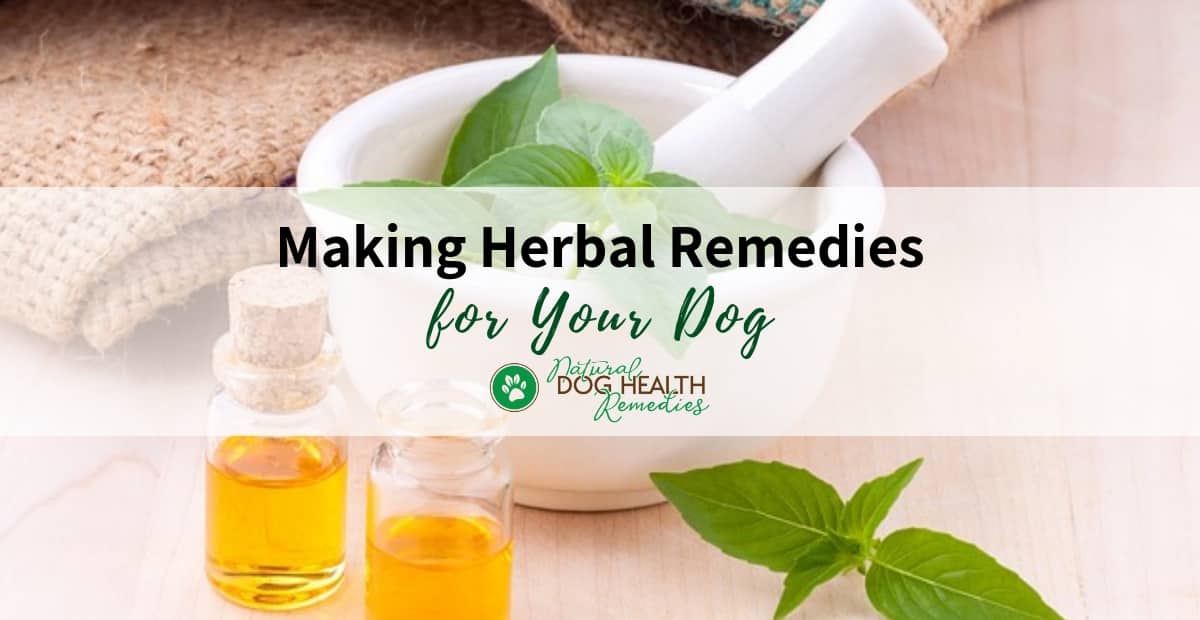Making Herbal Remedies for Your Dog

It is a lot of fun to make herbal remedies such as tinctures and ointments. Armed with some basic knowledge and after some practice, anyone can make them at home.
How to Select Herbs
Fresh Herbs
- Select fresh-smelling, healthy-looking plants with green leaves.
- Avoid herbs with brown, or moth-eaten leaves.
- If you pick your own herbs, pick them at their peak and after the morning dew has dried.
- Be sure that the herbs you are going to pick have not been treated with pesticides and herbicides.
Dried Herbs
- Select herbs that are dry but not too brittle (brittle and crunchy leaves indicate that the plants are too old).
- Choose herbs that are dry but still retain a bright green color.
Making Herbal Teas / Water Infusions
Herbal teas, or water infusions, are made by steeping a specific amount of herb in hot water. Chamomile, peppermint, and most other leafy herbs and flowers lend themselves to this method.
The pot or container used to steep the tea should be non-metallic since metal pots can interfere with the purity of the tea. Also, do not use tap water. For best results, use either distilled, filtered, or bottled spring water.
How to Make Water Infusions
Proportions of herbs to water
- 1 tsp dried herb per cup of water
- 1-2 tablespoons fresh herb per cup of water
- 4-6 tsp dried herb per quart of water
- 1/4 to 1/2 cup fresh herb per quart of water
Directions
- Steep the herb in the hot water (the water should be heated to just below the boiling point) for about 15 minutes.
- Strain out the herb and allow the tea to cool.
Dosage to be Administered to Dogs
How much of an herbal preparation should be given to your dog depends on his size.
For dogs that are:
- 1 to 10 pounds, add no more than 1/4 cup of tea to their food or water, 1 to 3 times a day.
- 11 to 20 pounds, add 1/4 cup to their food or water, 1 to 3 times a day.
- 21 to 50 pounds, add 1/4 to 1/2 cup to their food or water, 1 to 3 times a day.
- 51 to 100 pounds, add 1/2 to 1 cup to their food or water, 2 to 3 times a day.
Some water infusions can also be used topically as skin rinses.
Un-used herbal teas should be stored in glass jars (not plastic containers) and can be kept in the refrigerator for several days or up to a week. You can add 1-2 drops of grapefruit seed extract per cup of herbal tea before refrigerating to prolong the tea's life. GSE is a natural and safe preservative.
Before using leftover tea, make sure that it has not gone bad - if it has turned moldy or has a strange smell, discard it.
Making Herbal Decoctions
A decoction is a boiled tea. Roots and seeds (and some leaves as well) are brewed in this method.
Use a stainless steel, glass, or enameled pan with a tightly fitting lid. If roots (fresh or dried) are used, cut them into small pieces.
How to Make Decoctions
Proportions of herbs to water
- 1 tsp dried herb per cup of water
- 1-2 tablespoons fresh herb per cup of water
- 4-6 tsp dried herb per quart of water
- 1/4 to 1/2 cup fresh herb per quart of water
Directions
- Put the herb and water in a pan. Cover and bring to a boil.
- Reduce heat and simmer for 15-20 minutes.
- Remove from heat and let stand for about 10 minutes or until cool.
- Strain out the herb.
Dosage to be Administered to Dogs
Give 1/2 to 1 teaspoon per 10 pounds of body weight to your dog daily. The decoction can be added to the dog's food.
Leftovers can be refrigerated for up to a week, but again, check before using! If it appears moldy or has a strange smell, discard!
Making Herbal Tinctures
Basically, a tincture is made by soaking a measured quantity of fresh or dried herb in a solvent.
Two major solvents used in herbal tinctures are alcohol and glycerin.
Generally speaking, alcohol can extract more of the herbs' active ingredients than glycerin. However, some animals may not like the taste of alcohol. Moreover, alcohol may cause allergic reaction or stomach irritation to some animals.
For use in dogs, therefore, it may be better to use the glycerin tinctures. They can be added to the dog's drinking water or even his food.
How to Make Herbal Tinctures
Items Needed
- Dried or fresh herbs in powdered or cut form
- 40 percent alcohol, e.g. vodka or brandy (DO NOT use rubbing, isopropyl or wood alcohol) OR glycerin
- Wide-mouthed glass jars with lids
- Unbleached cheesecloth
Directions
- Add the amount of herb you desire into the glass jar.
- Add either alcohol or glycerin until the herbs are entirely covered.
- Stir the mixture until the herb and the liquid are mixed.
- Seal the jar tightly.
- Label the tincture jar with the date, the herb and solvent used!
- For the first few days, you may need to stir the tincture or add more liquid (alcohol or glycerin) to the mixture.
- Store the jar in a dark area for 6 weeks.
- Strain the mixture through a cheesecloth and store the liquid in another jar or dark colored tincture bottle.
- Close the storage container with a stopper or cap.
- Don't forget to label the tincture with the date, the herb and solvent used!
- Store the tincture in a cool dark place. (Glycerin tinctures will keep longer in the fridge.)
Dosage to be Administered to Dogs
How much of an herbal preparation should be given to your dog depends on his size.
For dogs that are:
- 1 to 10 pounds, add 1 to 3 drops of a tincture to their food or water, 2 to 3 times a day.
- 11 to 20 pounds, add 3 to 5 drops of a tincture to their food or water, 2 to 3 times a day.
- 21 to 50 pounds, add 5 to 10 drops of a tincture to their food or water, 2 to 3 times a day.
- 51 to 100 pounds, add 10 to 20 drops of a tincture to their food or water, 2 to 3 times a day.
Topical Herbal Remedies
Making herbal remedies for topical use (such as ointments and oil infusions) is not as difficult as you think - just takes a bit of time and patience! Please click here to learn how to make salves, oil infusions, poultices and spritz for your dogs.





